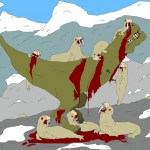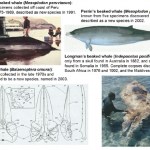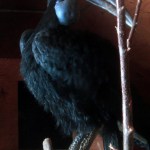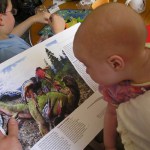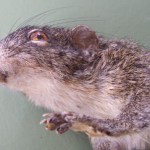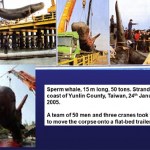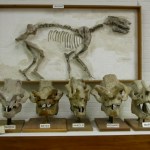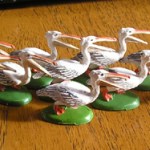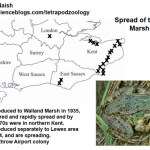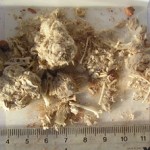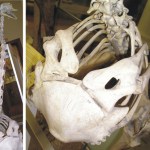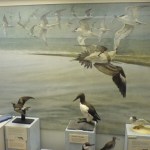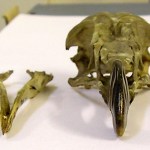picture of the day
This work comes out in a few months though, as you can guess, I have my own advance copy already...
Much more in due time. As before, see if you can identify any of the other works visible (just about) on the shelves. Some are easier than others!
UPDATE: Well done if you had a go at guessing the books visible in the shot above. Yes, that's The Dinosauria (softback 1992) and Paul's Dinosaurs of the Air at far left, with Matt Wedel's 2007 PhD thesis Postcranial Pneumaticity in Dinosaurs and the Origin of the Avian Lung sandwiched in between. The slim, white and blue volume to the left of Matt'…
Neil 'where the fudge are my thalattosaurs' Kelley once brought my attention to the following piece of art...
I thought about saying something intelligent, but decided not to.
UPDATE: the image comes from here: Valin Mattheis's flickr site, and I hope I'm ok in using it.
In time-honoured tradition, here are some slides from one of my talks. They're self-explanatory, but let me know if elaboration is required...
Anecdotal data and modelling work suggests that a few more species are yet to come - and more on those at some stage in the future. And if you want references for the new species featured above...
Beasley, I., Robertson, K. M. & Arnold, P. 2005. Description of a new dolphin, the Australian snubfin dolphin Orcaella heinsohni sp. n. (Cetacea, Delphinidae). Marine Mammal Science 21, 365-400.
Dalebout, M. L. 2002., Mead, J. G., Baker, C. S., Baker, A…
Ground hornbills - or bucorvids - have been Tet Zoo mainstays since the early days of 2006. However, the only species that I ever feature is the Southern ground hornbill Bucorvus leadbeateri (sometimes incorrectly referred to by one of its junior synonyms, B. cafer). It's easily recognisable for its red facial skin and low casque.
To bring balance, here's the other species: the Abyssinian or Northern ground hornbill B. abyssinicus (this one photographed at Dublin Zoo). In contrast to its close relative, it has a much taller casque, and blue facial skin. Its throat pouch is blue in females…
I'm sure you'll agree that there have been way too many dinosaurs on Tet Zoo over the past few weeks. Let's balance things out by showing a cute little rodent. Your challenge: to identify it to species and - if at all possible - to say something quite interesting about the animal, or about the group to which it belongs. Good luck, and don't stop until we get to 100 comments...
Here's a recent photo showing the proofs of one of my books. These particular pages (which focus on the 'dinosaur renaissance' of the 1960s and 70s) feature a Luis Rey piece: as usual, poor Tenontosaurus is getting dispatched by a Deinonychus gang. As you can see, Emma thought the picture looked neat (Will plays with Lego power miners in the background. The photo has already been featured here at Querencia)...
I sent the photo round to a few friends. Comments so far have included "I think it's more she is querying the extent of feathering, surely?", "That is beautiful * you will get it…
Here is a Secretary bird Sagittarius serpentarius skeleton I photographed some time ago: as usual, apologies for my terrible photography. The bird is lying on its back, and both its wings and legs are folded up. I would like you to concentrate in particular on its humeri: what the hell is going on?
Here's a close-up. Both humeri were like this. It looks as if they were broken mid-shaft, and then healed, but with the two halves of the shaft being totally misaligned (though I'm not saying that this is necessarily what happened: I really don't know). You might assume that a bird with injuries…
Welcome to a week of honest-to-goodness 'text-lite' posts. Yeah, I've made promises about going 'text-lite' before, but I've failed to deliver. This time I'm determined to succeed. We begin with these pretty pictures, provided by Greg Popwell and showing a taxiderm specimen of.. of... well, what? Over to you...
As usual with these sorts of things, apologies if this insults your intelligence. The animal is about 18 cm long.
UPDATE: thanks to all who had a go at identifying the animal. It's obviously a rodent, and obviously a squirrel (long bushy tail, pentadactyl hands, forelimbs and…
Here are assorted relevant things that happened in March: ahh, what a month. First of all, another sea monster. It's the famous fishy-crustaceany monster thing at Plymouth Hoe Barbican...
Here's a dead Mute swan Cygnus olor I found among all the rubbish during the Chessel Bay clean-up. I have its head.
And here's a dead female Bullfinch Pyrrhula pyrrhula a friend gave me. Why do finches so often have those big callouses on their feet? Is this the same thing as the bumblefoot infection that sometimes affects captive birds? Bullfinches are carduelines, most closely related to hawfinches and…
.... but the whale had been sitting around, decomposing, for several days...
Pity the person who came back to collect their parked scooter at the end of the day...
Here's a photo Matt Wedel took in the Raymond Alf Museum in Claremont, California. The lined-up skulls belong (I think) to Megacerops, the large to very large Late Eocene brontothere previously known as Brontotherium. Like most other brontotheriine brontotheres it has reduced, globular upper incisors and is very wide at the back of the skull. The upper incisors were in fact so small that they might have been virtually useless, and these animals probably relied on a prehensile lip to gather food. Must stop there - want to start talking about horns and evidence for intraspecific combat, but…
No time. Too busy. Toy pelicans from Marwell Zoo. Accompanying thoughts from Dave Hone here; involves azhdarchids. Bye now, sorry for lack of substantive content.
Yeah, like it says in the title.. what is wrong wih this hippo? (photographed at Plymouth Museum and Art Gallery). Or, 'was' wrong.. given that it's now dead. I really should say more about hippos at some stage. So far there's only this, and that's just not good enough.
What fun we've all had, discussing corpses and decomposition. Thanks to all who participated. I'm going away for a couple of days. For no good reason other than that it looks good, find here a slide from a talk I do called 'Britain's changing herpetofauna'. I think it's pretty self-explanatory! The pic of the Marsh frog Pelophylax ridibundus is by Neil Phillips - thanks Neil :)
I picked up a lot of dead stuff in Morocco. One of the neatest things I brought back was this very large owl pellet (now broken into bits), discovered by Dave Martill at the same place where we were awoken at night by big, hooting owls assumed to have been Desert eagle owls Bubo ascalaphus [back-story here]...
As you can see (close-up below), it's stuffed full of rodent bones, at least some of which are (I think) from jerboa. So far I've only had a cursory look, but bones belonging to several individuals of more than one species are present. If and when I get round to extracting and…
Well, arguing about the physiology of Mesozoic archosaurs has been fun but I just can't put the time into it. Moving on, here's something entirely different...
Excuse my crappy photographic skills, and well done you if you can identify any/some/all of the species concerned. To those who don't know: yes, kookaburras (the four or so species of Dacelo) are gigantic kingfishers. We also have a few paradise kingfishers (Tanysiptera) in there, stork-billed kingfishers (Halcyon), pied kingfishers (Ceryle) and an American green kingfisher (Chloroceryle) - in all, a pretty good representation of…
Inspired by the kiwi weirdness looked at here recently, I thought I'd focus on some other ratite skeletal stuff. But the idea here isn't to identify the animal. This is obviously the skeleton of an ostrich Struthio camelus. The question for you is a simple one: what's going on with the pectoral girdle? What makes it weird? Hmm, I wonder...
Over the weekend Will and I visited another local museum: this time Westbury Manor Museum, Fareham (Hampshire, England). I particularly liked the several bird paintings they have on display, one of which - the one you can see here - was duplicated and enlarged and used as the back-drop to a case of stuffed local birds.
Despite strenuous efforts I've failed to find out who the artist was: the website gives no information, and if there was labelling I somehow missed it. It's not Charles Tunnicliffe by the way [UPDATE (added January 2010): the artist is Dan Powell. See comment 12 below].…
Test your skills and impress us all by identifying the object! Dammit, missed Atomic Betty...

